We are pleased to announce the availability of the updated Open Greek New Testament Bible (OGNT) this 27 October 2018. This is a significant update from versions 1 and 2 to version 3 (please visit https://github.com/eliranwong/OpenGNT for details of the changes). This is courtesy of Eliran Wong, the module creator (https://github.com/eliranwong/OpenGNT).
Download and usage issue: In case the default font of MySword for all text was changed to Koine Greek, please go to Preferences, tap Fonts and change the Font to Default or download another font and use that as the new Font and not the Koine Greek (MySword by default will select the first font in the fonts folder so in case you have not downloaded any font, a font in the modules with packaged font will be used).
Open Greek New Testament Project aims to:
- offer a FREE NA-equivalent text of Greek New Testament, compiled from open-resources;
- align a FREE NA-equivalent Greek New Testament with a group of high-quality and open-source materials;
- develop an online reader for FREE ACCESS of major resources integrated in this project. [OpenGNT.com]
The FREE NA-equivalent text is named as "Open Greek New Testament [OGNT]". The text of OGNT was built upon and compiled from a group of high-quality scholarly materials. It serves as the base text for the rest of the project. This provides all bible readers, students or scholars a FREE text of Greek New Testament, which is the closest equivalent to the text of NA28 / NA27, for studies or research purposes.
As the text of OGNT is close to the text of NA28 / NA27, OGNT is a very good candidate for bridging a free Greek New Testament text with resources, which were originally keyed to the text of NA28 / NA27. So far, Open Greek New Testament Project has successfully aligned the text of OGNT with various scholarly resources, e.g. Tyndale Amalgamated NT Tagged texts, OpenText Linguisitic Annotations, Levinsohn Greek New Testament Features, Mounce Greek-English Dictionary, Berean interlinear translations, etc.
Files/Modules included:
- OpenGNT.bbl.mybible - Open Greek New Testament Bible (OGNT).
Each word entry contains the following:
- accented Greek word
- Tyndale House's extended Strong's number - Dictionary is included (please see Open GNT Lexicon below)
- morphology code with lemma
- transliteration - can be tapped to show detailed information about the Greek word (instead of using the Greek for the dictionary link, the transliteration was used so that it will not conflict with the MySword Deluxe version feature Strong's links on text which collapses the Strong's number and morphology into one link via the Greek word).
- modern pronunciation
- English gloss
- Edition(s) [in case it's not BINRSTWH to limit the number of links] and variant(s) [if any] as Notes link (*). Note that this feature was retained though it can already be achieved by the detailed information via the word link in the transliteration.
Variant indicators:
- B = Byzantine
- I = NIV Greek
- M = NA28
- N = NA27
- R = Textus Receptus
- S = SBLGNT
- T = Tregelles's GNT
- W = Westcott-Hort
- H = Tydale House GNT
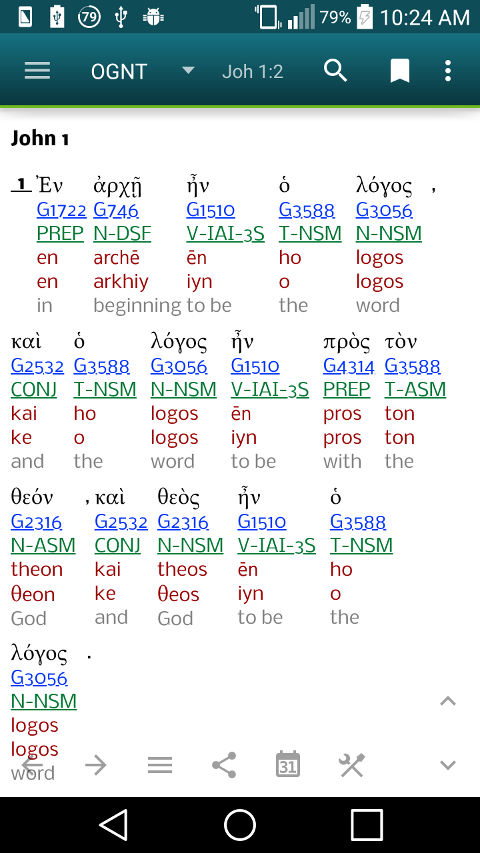
- OpenGNTOTLA.bbl.mybible - Open Greek New Testament with OpenText.org Linguistic Annotations (OGNTla). This updated module replaces the old OTGNT which replaced the name and abbreviation to avoid confusion.
This contain the OpenText.org v0.11 syntax annotations that were given to Logos Bible Software when they licensed the OpenText.org annotations in 2005. Each word entry contains the following:
- Function
- w# - opens a popup that contains more information like Strong number, Morphology, Lemma, etc.
- Greek word - opens a popup that contains more detailed word information than the w# above.
- English gloss
Other notations:
- Chapter:verse.word-group (e.g. 1:13.w7-w12) refers to a clause.
- @ indicates clause connection, e.g. 1:13.w7-w12@1:13.w1-w6 means 1:13.w7-w12 connects to 1:13.w1-w6.
- → indicates next (clause)
- ← indicates previous (clause)
- * indicates projected (clause)
Remarks: A helpful article is available at: http://opentext.org/resources/articles/a8.html, and section About OpenText.org Linguistic Model used for Annotation and Analysis below.
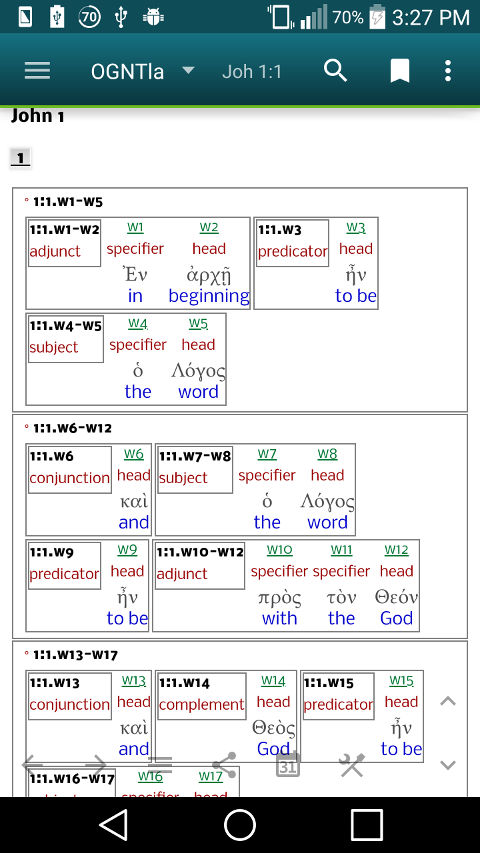
- OpenGNTa.bbl.mybible - Open Greek New Testament Project (OGNTa) in accented Greek.
- Clause division is represented by a highlight when a word within the clause is tapped (the tapped word itself has a different highlight).
- Detailed information is shown in a dictionary entry when a word is tapped.
- OpenGNTbe.bbl.mybible - Open Greek New Testament + Clauses + Berean Translations (OGNTbe). This module is similar to OGNTa above with Berean Translations below each verse.
- Clause division is represented by a highlight when a Greek word within the clause is tapped (the tapped word itself has a different highlight).
- ⚐ at the beginning of a Clause can be tapped to get Clause information.
- ⊕ at the beginning of a Greek word can be tapped to get the Levinsohn Greek New Testament Discourse Features (LGNTDF).
- Detailed information is shown in a dictionary entry when a Greek word is tapped.
- The 3 Berean Bible translations (Interlinear, Literal, Study) are presented in boxes per clause division.
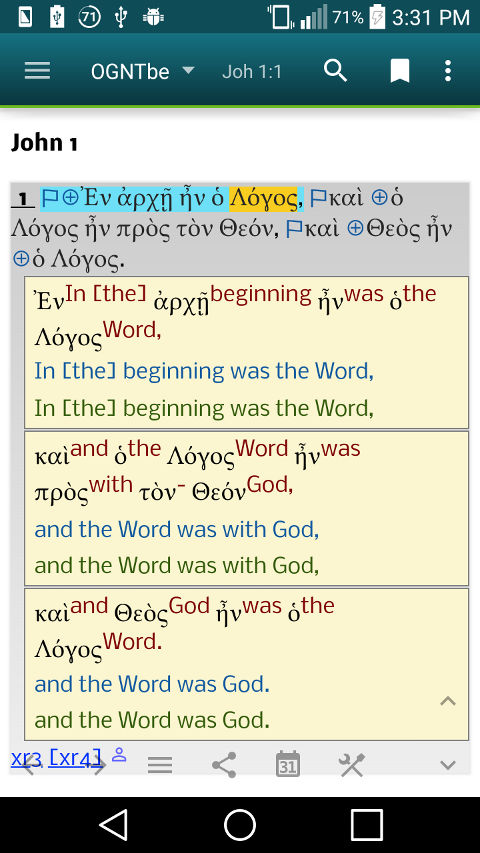
- OpenGNTnet.bbl.mybible - Open Greek New Testament + The NET Bible® verse text (no Notes) - 2nd Edition; New Testament + Discourse Features (OGNTnet). This updated module replaces the old OGNT-NET with OpenText Linguistic Annotations in brackets but the function can also be achieved already by OGNTla above and the shortcut form in the updated OGNTnet module similar to OGNTa above.
- Clause division is represented by a line break, with each clause starts with a symbol °.
- Clause division is represented also by a highlight when a Greek word within the clause is tapped (the tapped word itself has a different highlight).
- Detailed information is shown in a dictionary entry when a Greek word is tapped.
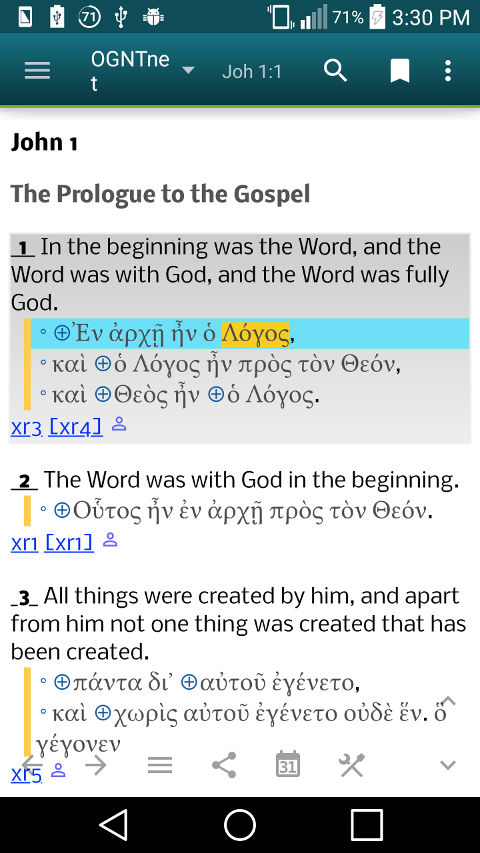
- OpenGNTk.bbl.mybible - Open Greek New Testament formatted in Koine Greek (OGNTk). This module was created for the purpose of searching and for advanced users who read ancient manuscripts. Formatted in Koine Greek: The lunate sigma “C” is used as in early New Testament manuscripts, instead of the miniscule sigma “σ” and terminal sigma “ς” used since the Middle Ages. Similar to OGNTa clauses can be highlighted by tapping a word and detailed information about the word will be shown in dictionary lookup.
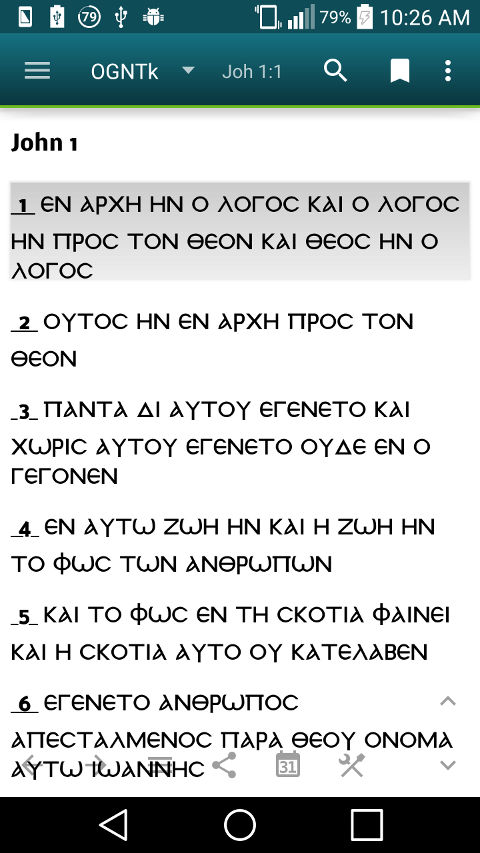
- OpenGNTd.dct.mybible - Open Greek New Testament dictionary (OGNTd) containing detailed information for each Greek word:
- Levinsohn Greek New Testament Discourse Features (LGNTDF) Clause information with Berean Interlinear, Literal and Study Bible clauses.
- Word information:
- Accented, Unaccented, Transliteration, Modern pronunciation
- Gloss, Interlinear, Literal, Study, Español
- RMAC
- TBESG, Mounce, BDAG, EDNT, Strong, GK, LN (only entry references for copyrighted materials)
- Tyndale Amalgamated NT Tagged texts with Editions, Strong, gloss, RMAC
- OpenText Linguistic Annotation - Word Level information.
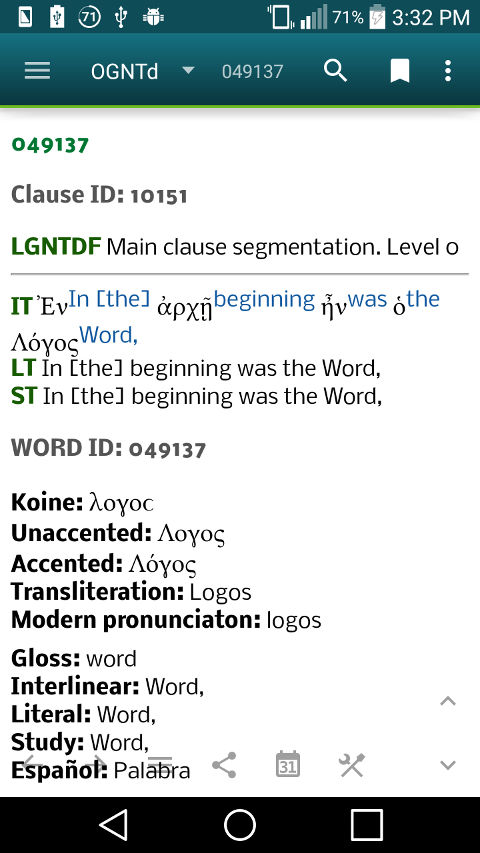
- OpenGNTLexicon.dct.mybible - An Analytical Lexicon on Open Greek New Testament + Tyndale Brief lexicon of Extended Strongs for Greek (OGNT).
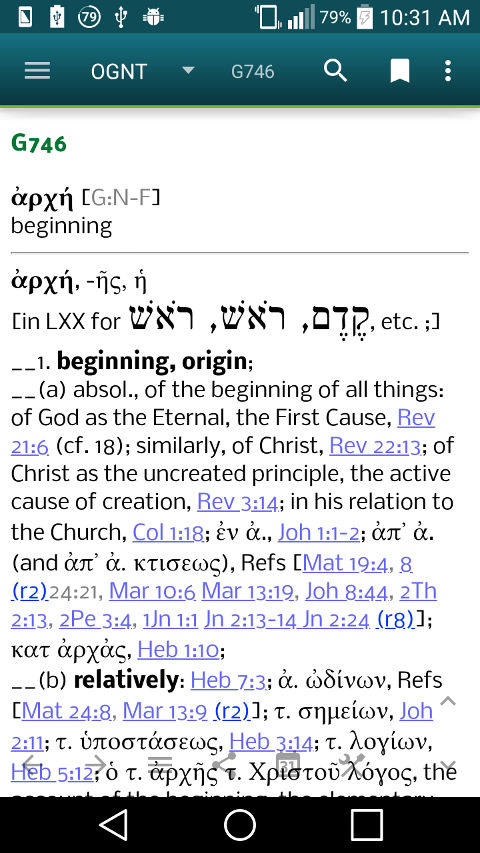
- OpenGNTRMAC.dct.mybible - Robinson's Morphological Analysis Codes Dictionary (OGNTRMAC). This is an enhanced version of RMAC dictionary for description on morphological codes. Please note that it will not replace the official MySword RMAC dictionary, which has only 1100 entries. Eliran Wong fixed wrong entries found in the original one, reformatted and added an extra 289 entries in this enhanced version.
- Mounce.dct.mybible - Mounce Concise Greek-English Dictionary of the New Testament (Mounce), edited by William D. Mounce with Rick D. Bennett, Jr. This dictionary includes all the Greek words that occur in the standard Greek New Testament, and is organized in alphabetic Greek order. The first items of each entry includes the G/K and Strong’s number. Strong’s numbers followed by a lowercase letter (a, b, etc.) represent forms not included in the original Strong’s system that were modified to conform to modern editions of the Greek New Testament. This same system is employed in the various Key Number tagged texts in Accordance such as the ESV, NRSV, HCSB, and NKJV. Following these are the Greek word, its transliteration, and its frequency count is also included. On the next lines are the English definition, and for all words occuring 10x or less, each Scripture reference is included.
Old Files/Modules no longer supported:
- OpenGNT-NET.bbl.mybible - Open Greek New Testament + OpenText Linguistic Annotation + Clause boundaries (blue brackets in superscript) + Phrase boundaries (red brackets in superscript) + The NET Bible® verse text (no Notes) - 2nd Edition; New Testament (OGNT-NET). This is replaced by the new OGNTnet.
- OpenGNTi.bbl.mybible - Open Greek New Testament (Inline Interlinear Tyndale House's glosses w/ variants); sub-meanings of pronouns worked out by Eliran Wong (OGNTi). Function can already be achieved by available modules above.
- OpenGNTii.bbl.mybible - Open Greek New Testament (Inline Interlinear Tyndale House's glosses w/ variants + Tyndale House's extended Strong's numbers + James Tauber's morphology) (OGNTii). Function can already be achieved by available modules above.
- OpenGNTd.bbl.mybible - Open Greek New Testament (w/ inline commentary of Levinsohn's GNTDF + Levinsohn's clause division + textual variants) (OGNTd). This is replaced by the new OGNTa.
License:
The main text of Open Greek New Testament Project, OGNT in short, is released under the following license:
Open Greek New Testament Project by Eliran Wong is licensed under a Creative Commons Attribution-ShareAlike 4.0 International License.
Based on a work at https://github.com/eliranwong/OpenGNT.
Online Reader is available at https://OpenGNT.com.
Permissions beyond the scope of this license may be available at https://biblebento.com/contact/contactform.php.
Information given for attribution:
Open Greek New Testament Project by Eliran Wong is licensed under a Creative Commons Attribution-ShareAlike 4.0 International License.
Based on a work at https://github.com/eliranwong/OpenGNT.
Online Reader is available at https://OpenGNT.com.
Permissions beyond the scope of this license may be available at https://biblebento.com/contact/contactform.php.
Other Credits:
STEPBible-Data:
"Tyndale House, Cambridge" [www.TyndaleHouse.com],
and "STEP Bible" [www.STEPBible.org]
and source at tyndale.github.io/STEPBible-Data/
Bunning Heuristic Prototype Greek New Testament:
Bunning, Alan, ed. (2017) Bunning Heuristic Protoype Greek New Testament. Preliminary Draft, December 29, 2017.
https://github.com/greekcntr/BHP
Berean Interlinear Bible
The Holy Bible, Berean Interlinear Bible, BIB
Copyright ©2016, 2018 by Bible Hub
Used by Permission. All Rights Reserved Worldwide.
berean.bible - Berean Bible Homepage
interlinearbible.com - Berean Interlinear Bible
literalbible.com - Berean Literal Bible
bereanbible.com - Berean Study Bible
emphasizedbible.com - Berean Emphasized Bible
The OpenText.org Syntactically Annotated Greek New Testament
Stanley E. Porter
Matthew Brook O'Donnell
Jeffrey T. Reed
Source: GNT Annotation (version 1.0)
This annotation was completed in 2006 and was made available for viewing on the OpenText.org website and also implemented in Logos bible search software.
The annotation data has been migrated to a new, inline XML format by Christopher Land and the base text has been corrected and updated to the NA28 by Christopher Land and Ryder Wishart.
Levinsohn's Greek New Testament Discourse Features
Stephen Levinsohn's complete discourse features markup of the Greek New Testament (UBS4/NA27). This data was originally developed in BART and follow principles Levinsohn documented in his volume of Discourse Features of New Testament Greek.
Source: https://github.com/biblicalhumanities/levinsohn
©2016 SIL International
License
Released by:
Paul O'Rear
Associate Coordinator
International Translation
SIL International
NET Bible Copyright 2nd Edition (2017)
The NET Bible® verse text (no Notes) can be used by anyone and integrated into your non-commercial project or publication upon condition of proper Biblical Studies Press copyright and organizational acknowledgments ... (http://netbible.com/net-bible-copyright)
Copyright and organizational acknowledgments:
NET BIble® Copyright THE NET BIBLE®, New English Translation (NET) Scripture quoted by permission. Quotations designated (NET) are from the NET Bible® copyright ©1996-2016 by Biblical Studies Press, L.L.C. http://netbible.com All rights reserved. The names: THE NET BIBLE®, NEW ENGLISH TRANSLATION COPYRIGHT (c) 1996 BY BIBLICAL STUDIES PRESS, L.L.C. NET Bible® IS A REGISTERED TRADEMARK THE NET BIBLE® LOGO, SERVICE MARK COPYRIGHT (c) 1997 BY BIBLICAL STUDIES PRESS, L.L.C. ALL RIGHTS RESERVEDSATELLITE IMAGERY COPYRIGHT (c) RØHR PRODUCTIONS LTD. AND CENTRE NATIONAL D'ÉTUDES SPATIALES PHOTOGRAPHS COPYRIGHT (c) RØHR PRODUCTIONS LTD.
The CHINESE STANDARD BIBLE© Simplified and Traditional texts
The CHINESE STANDARD BIBLE© Simplified and Traditional texts and audio versions of the same, Copyright © 2005, 2008, 2011 by Global Bible Initiative are licensed under the Creative Commons Attribution-Non Commercial-No Derivatives 4.0 International License. To view a copy of this license, visit http://creativecommons.org/licenses/by-nc-nd/4.0/ or send a letter to Creative Commons, PO Box 1866, Mountain View, CA 94042, USA. Permissions beyond the scope of this license may be available and may be requested by contacting
Learn More at https://www.globalbibleinitiative.org/
Remarks: OpenGNT project confirmed with Ken Stephens, Director of Publishing and Donor Engagement of Global Bible Initiative, that aligning the text of CSB with a Greek text, without changing its wordings, is permitted.
Chinese Equivalent Koine Grammar And Syntax
中文代表字原文新約聖經
基礎文法 及 經文結構分析
Copyright 2005~2018 by BRSI
(聖經研讀學會 Bible Research Study Institute)
Permission to all Christians for use, study or share.
Source: http://www.ssjcbc.com/bibleresearch/bible_reaserch2.html
Chinese translation by Stephen Ku and Eliran Wong
RMAC's description
OpenText Linguistic Annotations
Mounce Concise Greek-English Dictionary
Source: https://github.com/billmounce/dictionary
Used with the following attribution:
Mounce Concise Greek-English Dictionary
Copyright 1993 All Rights Reserved
www.teknia.com/greek-dictionary
Spanish Literal Translation
La traducción al español fue mapeada y ajustada por E. Barrientos al texto del Proyecto OGNT del módulo para el Programa E-Sword del Proyecto GALEED 2017 "Una traducción literal palabra por palabra al español" auspiciado por Biblioteca Hispana, Última Revisión: 01 de febrero de 2017 que contiene una traducción literal del Texto Griego Maestro NA27.
[The translation into Spanish was mapped and adjusted by E. Barrientos to the text of the OGNT Project of the module for the E-Sword Program of the GALEED Project 2017 "A literal translation word for word into Spanish" sponsored by Biblioteca Hispana, Last Revision: February 1 of 2017 that contains a literal translation of the Greek Text Master NA27.]
Morphological Lexicon of the Greek New Testament
Source: https://github.com/morphgnt/morphological-lexicon
It is used to process data for mapping purpose.
The Copenhagen Alliance for Open Biblical Language Resources
http://copenhagen-alliance.org
Advice about licensing.
Comparison between OGNT & NA28:
Differences between words of OGNT and NA28 are placed HERE.
Words:
File: diff_main.tsv Apart from minor orthographical variations mentioned below, OGNT has only a total of 61 words different from NA28.
File: diff_minor.tsv Words are basically identical, only with minor orthographical variations like movable ν, αλλ / αλλα, etc.
Word Order:
File: diff_wordOrder.tsv OGNT has 3 verses different from NA28 in word order.
NA variants in all files stated above are represented by Greek variants available in TANTT - Tyndale Amalgamated NT Tagged texts, for reference purpose.
TANTT was used for comparison only after the text was compiled. It had not been used for the compilation of the base text of OGNT (version 3).
About OpenText.org Linguistic Model used for Annotation and Analysis
Introduction to the Annotation Model
The clause is recognized as the primary building block in the OpenText.org annotation model because it is the level at which propositions are made. The different types of annotations are thus built around the clause annotation, the word group annotation (which make up the clause components), and the relationship between clauses (including the distinction into distinct primary, secondary, and secondary embedded clause levels) as the base. Table 1 summarizes the major categories of tags for the clause and word group level annotations. The vertical axis of the table delineates the four basic clause level function slots. The horizontal axis of the table gives the three clauses levels. The information within the table refers to the word groups, which fit inside the clause function slots.
| Clause Level | Subject (S) | Predicator (P) | Complement (C) | Adjunct (A) |
|---|---|---|---|---|
| Primary | Head Term-Modifiers | Verbal Form | Head Term-Modifiers | Head Term-Modifiers |
| Secondary Unembedded | Head Term-Modifiers | Verbal Form | Head Term-Modifiers | Head Term-Modifiers |
| Secondary Embedded | Head Term-Modifiers | Verbal Form | Head Term-Modifiers | Head Term-Modifiers |
Clause Level Annotation
At the clause level, only four tags are used, excluding conjunctions between clauses (marked “conj”). To aid understanding, it is helpful to consider the clause functions in terms of function slots. All word groups fit into these function slots. There are only four function slots and they are:
- Subject (S)
- Predicator (P)
- Complement (C)
- Adjunct (A)
The tag subject (S) is used of a word group or the word groups of which something is predicated. (In traditional grammar the distinguishing term is “grammatical subject.”)
All verbal forms are tagged as predicators (P).
A complement (C) is a word group or the word groups that “complete” its predicator. Common complements are direct and indirect objects.
An adjunct (A) is a word group or the word groups that modify the predicator, providing an indication of the circumstances associated with the process. Common adjuncts are prepositional and adverbial phrases.
This annotation scheme reflects Halliday’s conception of the grammar of a clause (i.e., the transitivity system at the level of a clause). The subjects and complements in the clause level annotation correspond to the participants in a process; the predicators correspond to the processes; and the adjuncts typically correspond to the circumstances associated with the process, though some adjuncts are peripheral participants in a process.
Word Group Level Annotation Model
At the word group level, all words are basically either head terms or modifiers. The head term usually refers to the nominal that all the other words in the word group modify. Four types of modifiers are identified:
- specifiers (sp)
- definers (df)
- qualifiers (ql)
- relators (rl)
A specifier (sp) is a modifier that classifies or identifies the word it modifies. Common examples of specifiers are articles and prepositions.
A definer (df) is a modifier that attributes features or further defines the word it modifies. Common examples of definers are adjectives (both attributive and predicate structure) and appositional words or phrases.
A qualifier (ql) is a modifier that in some way limits or constrains the scope of the word it modifies. Common examples of qualifiers are words in the genitive and dative case.
A relator (rl) is a word specified by a preposition (i.e., the object of a preposition) that modifies another element within the word group.
Clause Levels
Clauses are divided into two levels: (1) primary clauses; and (2) secondary clauses. The primary and secondary distinction has to do with the two possible types of logical dependency, dependence (hypotaxis) or equality (parataxis). Primary clauses are connected to each other, while secondary clauses are connected to the primary clause to which it is dependent. The majority of primary clauses consist of clauses with a finite verb. Secondary clauses are typically distinguished by means of a subordinating conjunction. A second type of secondary clause, the embedded clause, involves the phenomenon of rank-shifting—a linguistic element is embedded to a level of grammar lower than the typical level at which it functions. The majority of secondary embedded clauses in Greek are participial and infinitival clauses.
Symbols used for clause levels in OGNTnet and OGNTla:
° - Primary
°° - Secondary
°°° - Embedded
Clause connections
Alongside the three levels of clause distinguished in the OpenText.org clause annotation is the concept of clause connection. Each clause is marked with a connect value which indicates the clause within the surrounding discourse to which it is most immediately relates. In the diagram below, this value is indicated at the beginning of each clause underneath the clause identifier.
Rom 1:13 OGNTla
adjunct
head
Οὐ
not
predicator
head
θέλω
I want
conjunction
head
δὲ
and
complement
head
ὑμᾶς
you
predicator
head
ἀγνοεῖν
to be ignorant
addressee
head
ἀδελφοί
brothers
conjunction
head
ὅτι
that
adjunct
head
πολλάκις
often
predicator
head
προεθέμην
I planned
predicator
head
ἐλθεῖν
to come
adjunct
specifier
πρὸς
to
head
ὑμᾶς
you
conjunction
head
καὶ
and
predicator
head
ἐκωλύθην
was prevented
adjunct
specifier
ἄχρι
until
specifier
τοῦ
the
head
δεῦρο
now
conjunction
head
ἵνα
in order that
complement
definer
τινὰ
some
head
καρπὸν
fruit
predicator
head
σχῶ
I may have
conjunction
head
καὶ
even
adjunct
specifier
ἐν
among
head
ὑμῖν
you
conjunction
head
καθὼς
just as
conjunction
head
καὶ
also
adjunct
specifier
ἐν
among
specifier
τοῖς
the
definer
λοιποῖς
remaining
head
ἔθνεσιν
Gentiles
So clause 1:13.w7-w12 connects to 1:13.w1-w6 (1:13.w7-w12@1:13.w1-w6). 1:13.w7-w12 is a secondary clause connected to a primary clause, so it is indented and said to depend on 1:13.w1-w6. The next non-embedded clause, 1:13.w13-w17 is also a secondary clause and it connects back to 1:13.w7-w12. However, it has been analyzed in a coordinate relationship (connected by καὶ) and so is not indented. In contrast, the following clause, 1:13.w18-w24, is subordinate to the clause it connects with (1:13.w7-w12) and is therefore displayed with a further level of indentation.
